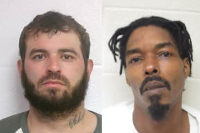Carrying the torch through history
 It’s all started with a phone call.
It’s all started with a phone call.
A lifelong thirst for adventure led Ronald R. Cooper to a love of backpacking, where he soon began hiking around the Grand Canyon and beyond. But, he was in search of a new challenge, one that ultimately tied together his Native American ancestry with his own modern existence.
The famous triple crown of American long-distance trails were calling in the background — the Appalachian Trail, Continental Divide Trail or Pacific Crest Trail — but Cooper was on a different kind of quest.
“I wanted to see if I could do a long hike,” the 45-year-old said. “I wanted to do one that had meaning, and then I came across this trail.”
That trek was the Trail of Tears, which Cooper, who currently resides in Whittier (near Cherokee), chronicled into his debut novel, It’s My Trail, Too: A Comanche Indian’s Journey on the Cherokee Trail of Tears.
Related Items
Stretching from the mountains of Tennessee to the open plains of Oklahoma, the 835-mile trail is regarded as one of the darkest chapters of American history. More than 15,000 Cherokee people were forced by the U.S. government to make the journey in 1838. They were rounded up and pushed from their homeland to newly designated territory in the West, with thousands dying of starvation, hypothermia and exhaustion along the way.
Alongside the Cherokee, other tribes, including the Chickasaw, Choctaw, Muscogee-Creek and Seminole (collectively called the “Five Civilized Tribes”), were also relocated in the 1830s.
Though hailing from the Comanche tribe in Oklahoma, Cooper had always known about the infamous trail. He wanted to do something to not only preserve its history but also expose others to the overall picture of Native Americans in this country and how it all translates into today.
“Even though it wasn’t my tribe that followed the trail, it still has meaning for me as a Native American,” he said. “A lot of my culture, the Comanche culture, is lost and dying, so I took it up to get pieces together from all tribes and what being a Native American was like back then.”
He began to look for information on where it started, ended and what was in between. Recognized as a historic trail by the National Park Service, it seemed, at first, it wouldn’t be too difficult to get the ball rolling.
Wrong.
“I thought it would just a simple matter of calling the park service and asking for maps,” he chuckled. “They couldn’t provide me with that. All they did was give me a general idea of where the trail is. They had no idea on how to walk it. I couldn’t believe they didn’t have anything.”
Far from discouraging him, however, that phone call sealed the deal, his interest piqued not only by the allure of the journey itself but also by retracing footsteps buried by time.
Cooper dove further down the rabbit hole of research. He combed the Internet, numerous books and contacted historical societies. Though he thought there might be wilderness sections of the trail, it turned out most of the trail followed popular travel routes during the 19th century, which nowadays have been transformed into highways and interstates.
It took nearly a year, but eventually, a clearer picture emerged, and by January 2011, he was ready to begin his journey.
At the time, he and his wife, Kristal, were working for Amazon.com in eastern Tennessee, living out of their RV, which gave them the freedom to pull up the stakes and move whenever they wanted to.
The original plan was for Cooper to pack enough food for a three-day walk, sleep in a tent along the route and every few days meet back up with Kristal (who was steering the RV ahead of his trek) for a quick rest and replenishment of supplies.
“It didn’t work out that way,” Ronald said. “I realized early on there was no public property to camp on. Everything was privately owned, and I was a little reluctant to camp on people’s land without asking permission.”
Deciding to change his strategy to a series of day hikes, averaging 15 or so miles day, Cooper would move along the route and meet up with his wife at the end of the day, then do it all over again in the morning. While on the route, he carried a handheld digital recorder, capturing his thoughts, things he saw and conversations he had with people he encountered, many of whom heard a Native American backpacker would be passing through thanks to advance media coverage of his wanderings.
Some would impart bits and pieces of history and lore that had been passed down by locals who lived along the Trail of Tears route, at times pointing him to the actual historic wagon road they would have passed over nearly two centuries ago.
But, besides all the unique people, places and things he crossed paths with, what surprised Cooper most was the graciousness and caring spirit of humankind. Before he began the trail, friends were telling him to keep a gun because of the dangers he may come across or to watch out for people that may throw things at him while he walked.
“But, on the trail, I mean from the first step to the last, I met nothing but great people along the way, people that just went out of their way to help me. That’s what opened my eyes the most,” he said.
Cooper was amazed at the variety in geography the trail meandered through. One section would run through downtown Nashville, another through an isolated pasture.
“You’d go through a city and then be walking on gravels roads,” he said. “I had to stop sometimes and make sure I wasn’t going up someone’s driveway because the road was so small.”
A longstanding tradition in Native American culture, Cooper was unable to get a blessing before his trip from his grandfather, a Comanche holy man. But when he was in Missouri, he met a Cheyenne medicine man that had heard about him doing the trail. The man offered to give Cooper a ceremonial blessing.
“And he gave me the blessing,” he said. “Here he was, a Cheyenne medicine man giving a Comanche a blessing on the Cherokee Trail of Tears.”
On April 20, 2011, some three months and three days since his trek began, Cooper crossed the Oklahoma border, at the end of the trail. It was a somber feeling, something that struck Cooper awkwardly.
“I woke up, and everything was quiet, because it was the end,” he said. “After three months, it became a routine, and suddenly, it was over. It took a little time to mentally realize I wasn’t going to be walking it again.”
But, Cooper had one more stop left before his quest came to a close, for him at least. In nearby Tahlequah, Okla., was the current headquarters for the Cherokee Nation, a place he wanted to walk his last miles toward.
“[The Cherokee] were gracious enough to have a little celebration for me at their heritage museum,” he said. “That’s where I ended my walk.”
With the trail behind him, Cooper now works as a blackjack dealer at Harrah’s Cherokee Casino and Resort. Landing a job in Cherokee is total coincidence — he needed a job when he finished the trail, and the casino happened to have one of the biggest pools of job openings in the Southeast.
He’s putting together a touring circuit for his book, which he hopes to include book signings, lectures and discussion about the trail.
“I think the Trail of Tears story needs to be retold every generation. People tend to forget. I figure there has got to be 25-year-olds walking around that don’t know what it is,” he said.
It’s all in an effort to keep the story alive, to not forget the transgression of the past and celebrate the strides made by Native Americans to comeback from oppression as resilient and prosperous.
“We’re in the 21st century now and I want Native Americans to see how far we’ve come,” he said. “I’m alive because a Comanche [ancestor] sacrificed to make the transition to modern ways. We should celebrate that story as much as the story of the sadness of the journey.”
Want a copy?
Ronald R. Cooper will be discussing his book, It’s My Trail, Too: A Comanche Indian’s Journey on the Cherokee Trail of Tears, at 2 p.m. Saturday, Jan. 12, at Blue Ridge Books in Waynesville and later that day at 6:30 p.m. at City Lights Bookstore in Sylva. Both events are free and open to the public, with copies already available for purchase. Copies can also be found at Books Unlimited in Franklin. Cooper’s journals and further endeavors can be found at Facebook.com (search: “RonHikesTrailofTears”).









